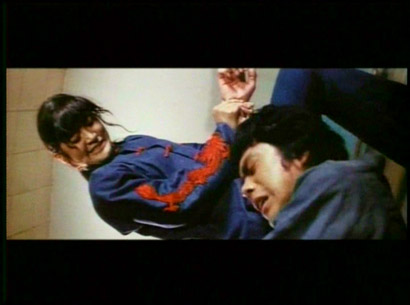
The Golden Bat
aka 黄金バット aka Ogon batto

1966
Written by Susumu Takaku
Directed by Hajime Sato

The Golden Bat is one of the best movies of all time. The Golden Bat is one of the craziest movies of all time. The Golden Bat is one of the funnest movies of all time. The Golden Bat is the reason movies were invented. You will watch The Golden Bat, or he will beat the tar out of you with his cane, laughing all the while!
A dreamlike haze of crazy costumes and duplications and maniac villains and monsters, The Golden Bat drags the tokusatsu genre to a surreal edge, pushing the boundaries of what a sane child would accept as proper plot progression while making great use of the black and white cinematography to give a gothic noir flavor. Sinister characters get shadows cast over them unnoticed by the good heroes. The set design is a wild 60s psychedelic take on pulp science fiction while using the light and dark contrasts to make the alien seem alien. Director Hajime Sato would later go on to direct the Bava-esque Goke – Bodysnatcher From Hell. Sato can take a straight scenario and bend it into a warped world, He would later put this pulp science fiction experience to work as a television director on Captain Ultra, which also features crazy surreal aliens that would be right at home in The Golden Bat.

Ogon Bat/Golden Bat was created in 1930 by writer Ichiro Suzuki and artist Takeo Nagamatsu for use in Kamishibai, a storytelling device where an entertainer would narrate a story for children as sequential wooden cards illustrate the exciting things that are happening. The Kamishibai merchant would make money by selling candy to the children who attend his shows. Kamishibai declined after World War 2, but a few story tellers still exist in tourist zones. The practice is said to date back to Buddhist monks in the 12th century, but the modern version used to entertain kids has it’s roots during the depression as a cheap way to entertain and make money.
Golden Bat is considered the first Japanese super hero due to these tales, and many more were created over the years (including adaptations of American heroes) Some of the art is collection in a few Kamishibai books, and slides are available for download on specialty Kamishibai sites. Ogon Batto would then appear in manga tales.

Golden Bat made his first film appearance with 1950’s Ogon bat: Matenro no kaijin (Golden Bat: Frankenstein Skyscraper). After thisThe Golden Bat film, 1967 saw an anime series, and the last official film adaptation was 1972’s Ogon Batto ga yattekuru (Golden Bat Shows Up), where a fat and stupid Golden Bat does presumably unfunny things. Neither of the other two films are easily available for watching, probably due to the lack of Sonny Chiba. There is an unofficial Korean Golden Bat film called Yong Gu and the Golden Bat (영구와 황금박쥐 – 1992) which is one of those awful awful Korean children’s films that you should never watch.


 |
Golden Bat (voice of Osamu Kobayashi, performer unknown) – Hero of Atlantis, Golden Bat took a nap because one day humanity would need him. It turns out they did, and thus he wakes up just in time to fight Nazo. Golden Bat beats people with his cane because that’s what cool people do. |
 |
Akira Kazahaya (Wataru Yamagawa) – Amateur astronomer who discovers that planet Icarus has gone off it’s course and will smash into the Earth. This is all you need to do to suddenly become invited to join the Pearl Research Institute and fight evil with science. Which Akira joins and does. |
 |
Bat (Himself) – Golden Bat’s bat, who lives as a pendant on Emily and acts as a calling device and spy for Golden Bat. |
 |
Nazo (Koji Sekiyama) – the self-proclaimed ruler of the universe, this four-eyed lunatic wants to destroy all other life in the universe so he will be the only life. Somehow that has given him followers who can’t put 2 and 2 together. Nazo’s latest target is the Earth. He hides out in his base, Nazo Tower, which can shoot lasers. Nazo can shoot lasers from his eyes and has a flying claw hand. In the pulp series, Dr. Erich Nazō (ナゾー) runs a crime syndicate based on world domination and wears a mask that resembles this alien form. |
 |
Keloid (Yoichi Numata) – Giggling maniac with a burnt face who likes torture. Is the chief goon of Nazo. At one point he impersonates Dr. Pearl. Yoichi Numata also appears in Female Prisoner #701 Scorpion and the first two Ring movies. |
 |
Piranha (Keiko Kuni) – Female goon of Nazo who impersonates Naomi for an extended period in an attempt of sabotage. She fails and is killed by Nazo. Keiko Kuni appears in Female Prisoner #701 Scorpion |
 |
Jackal (Keiichi Kitagawa) – A wolf man complete with hairy uniform, he is more of a shock troop of Nazo. |
 |
Nazo’s goons (various) – Dressed in all black, these faceless goons are disposable troops sent in service of their evil master. |
|
































